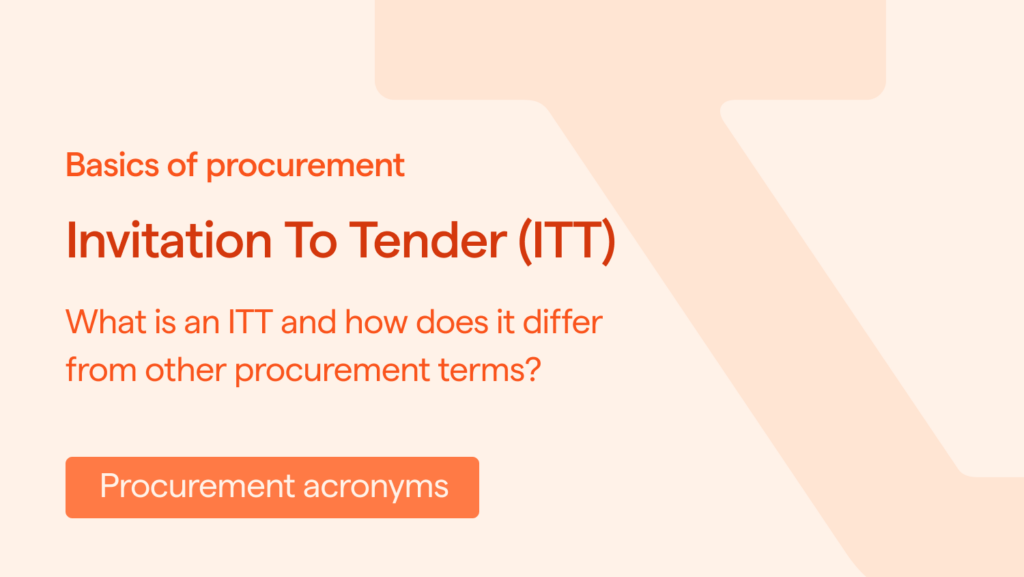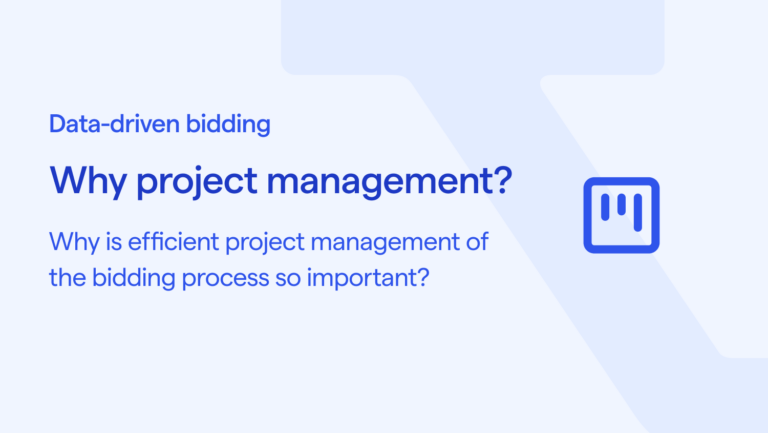The world of procurement is brimming with terms and abbreviations. Among them, ‘Invitation To Tender’ is a common phrase, most often abbreviated as ITT. It can also be known as ‘Invitation To Bid’ (ITB), a term used similarly but more prevalent in the US, while ITT is widely used in Europe. Yet another term you might encounter, and which infers the same or similar is ‘Invitation For Bid’ (IFB).
But what do these terms mean exactly? And how do they differ from a ‘Request For Proposal’ (RFP)? Keep reading to uncover the distinctions!
Invitation to tender – an overview
An Invitation To Tender is a formal request for potential suppliers and contractors to submit a proposal for the supply of goods, services, or works – the latter typically refers to construction projects or related activities. ITTs are used by organisations to select the most suitable provider(s) for a particular project or contract.
The ITT process requires prospective suppliers to provide detailed information, to clarify their ability to meet specific requirements. This information typically includes industry-specific details relating to technical capabilities, pricing, project management and timelines.
An Invitation To Tender enables a procuring organisation to compare and evaluate proposals and offers, to make an informed decision on the best-suited suppliers available to meet their expressed needs. ITTs are used by organisations to ensure they get the best value for money and that the chosen supplier(s) will be able to meet the requirements of the project. The ITT process also helps buyers identify potential risks or issues that may arise during delivery or the project timeline.
What’s the difference between an ITT and an RFP?
A Request for Proposal, or RFP, is one of the most common terms that you may come across in working with procurements. If you’re familiar with RFPs, you might be wondering how an ITT differs from an RFP.
An RFP is typically used for projects, products, or services that are a little more complex or require a degree of customisation. What an RFP may request is often broader in scope and can allow for a certain degree of flexibility, and buyers often expect suppliers to be more creative in their responses. In some instances, buyers issuing an RFP may even ask suppliers to define any limitations or potential constraints. In an RFP, the emphasis is most often on the supplier to submit a compelling yet competitive proposal, which aims to convince the buyer – albeit that buyers do still adhere to award criteria that are outlined as part of the RFP.
An Invitation To Tender on the other hand is more commonly used for standardised products and services, in instances where buyers most often have a clear and detailed understanding of what they seek. The organisation issuing an ITT will likely leave less room for suppliers to present custom solutions based on an interpretation of what is being requested. Instead, ITT processes often include a well-defined and clear set of requirements that must be met and are primarily focused on finding the supplier with the right pricing and terms. However, one should be careful of confusing this as merely a ‘best value for money’ exercise, as this is wording often included in both ITTs and RFPs alike.
If a buyer seeks innovative solutions, expertise, and a broader range of options, they’re more likely to use an RFP. On the other hand, if a buyer is primarily focused on a streamlined process whereby their specific needs (which are well-defined) are secured for the best price, an ITT is more likely.
An important caveat
Do note that in the vast world of procurement, buyers themselves are not always experts. As such, you might find that RFPs, ITTs, and other processes are used and communicated interchangeably. An ITT can also, depending on what is to be procured, request creativity – and an RFP can equally be slimmed down and more rigid in its request.
What to think about when responding to ITTs
If you’re new to public procurement and tender bid writing, the process can seem daunting. But don’t fret. Simply take it one step at a time.
Remember that in an Invitation To Tender, the buyer is more likely to choose suppliers that meet the requirements and that propose the most beneficial pricing offer. This might be more in your favour, or less, depending on your particular business or product. Remember that, in comparison with an RFP, an ITT will typically offer less potential to propose and suggest innovative solutions. Keep this in mind when deciding which tenders you bid on, and when writing your bid.
When you’re responding to the ITT, go through the steps below.
1. Review the documents thoroughly:
Make sure you read and understand all the details and requirements outlined as part of any documents released in conjunction with an ITT. To write a successful bid, it is vital that you have fully considered and taken into consideration the scope of the work, specifications, terms and conditions. And by no means can you miss the evaluation criteria, as this may better indicate the buyer’s intended direction and incentives.
2. Check that you comply with the requirements:
Ensure that you fully comply with the requirements specified in the ITT. Non-compliance, sometimes with as little as one requirement, can lead to disqualification. Make sure you are certain you meet the criteria before submitting your response.
3. Consider the contract terms:
Review the terms and conditions carefully. If there are terms that you cannot accept or need to negotiate, you should highlight these to the buyer. Do also be prepared to discuss any reservations you may have, and that a buyer may reject these.
4. Ask questions:
If you have questions or should need further clarification on a specific point or clause communicated in an ITT, reach out to the buyer. Almost all ITTs will include a point of contact or method in which questions can be submitted, and where answers are communicated in return. Any queries you may have should also be resolved before you submit a bid.
5. Write a clear response:
Present your response to the tender in a clear, organised, and professional manner. Sometimes templates and formats are provided in an ITT’s attached documents, or specific submission and response instructions are outlined. Be sure you use these, you do not want to be excluded on what might seem a silly technicality.
6. Address the technical requirements:
In any response, provide detailed information on how you plan to meet the technical requirements outlined as part of an ITT. This is where you can let your technical expertise shine, even if it is with diminished creativity.
7. Demonstrate quality assurance and compliance:
Show your commitment to quality assurance, and demonstrate your compliance with any relevant standards or regulations. You may also be asked to provide evidence of this.
8. Asses risks:
Identify potential risks associated with the procurement opportunity and present mitigation strategies if applicable. This will show that you have considered possible challenges and have a plan for addressing them.
9. Address confidentiality and intellectual property concerns:
Make sure you address any confidentiality or intellectual property concerns, especially if the project involves proprietary information or technologies. A competitive bid needs to be compelling, but it should not come at the risk of your business.
10. Clarify (if any) collaborative partners:
If an ITT would require or otherwise allow you to involve other organisations or subcontractors, clearly outline who they may be. In certain circumstances, you may need to provide risk assessments, existing agreements, or further details on your collaborations. In other instances, you may be asked to share more about your own team’s composition and their respective roles and responsibilities.
11. Share references and testimonials:
If requested, you should include references and testimonials from previous clients, customers or successfully won contracts. Make sure these declare a track record of successful deliveries and previous engagements.
12. Propose competitive pricing:
ITTs will in almost every instance include a request for pricing. Be sure to be transparent yet competitive in your pricing offer, including any associated costs. A buyer will most often place significant emphasis on the proposed price, and make their assessment and decision accordingly. Be certain that your price is accurate, as buyers will not take kindly to costs that spring up later on down the road.
13. Proofread and quality check:
A bid’s chances of success can be improved by ensuring you thoroughly review your proposal ahead of submission. Make sure you remedy any errors, typos, and inconsistencies, then check it again, and maybe a third time. A successful bid should not only persuade a buyer of your expertise but also showcase your proficiencies and demonstrate your professionalism effectively.
14. Meet the deadline:
Be sure to take note of the submission deadlines. Late submissions are in most instances grounds for immediate disqualification, and buyers will typically disregard any bid that is submitted after a lapsed deadline. Make sure you have the time and resources to prepare a complete and well-structured response.
15. Submit your bid:
It is paramount that you follow ITTs’ outlined submission instructions precisely. If an ITT directs you to submit via a portal, it will not be in your favour to circumvent this and submit your bid by email – you may be disqualified if you do. Do also make sure you provide each and every requested document, form, and attachment in the correct format. It is also important that you keep a record of your submission, should something go awry.
16. Prepare for post-submission engagement:
Be prepared for potential interviews, demos, presentations, or negotiations with the procuring organisation after a bis has been submitted. The process will often be outlined as part of the ITT documentation, but be sure to be responsive and ready to address any further questions or concerns that a buyer may have.
While the above steps are an initial introduction, keep in mind that buyers may frequently interchange and blend different procurement acronyms and required steps. The lines are rather blurry, and buyers are not always the experts in their own regard. Make sure to read instructions carefully, and follow the procurement’s wording rather than the process an acronym might more generally apply to.
Find interesting ITTs (and other procurements) faster with Tendium
Do you want to locate and qualify interesting and relevant Invitation To Tenders and other procurements efficiently? Are you seeking to simplify and streamline your overall bidding processes and increase efficiency? Give Tendium’s bidding platform a try! With automated summaries and smart workflows, our platform is improving procurement at each step.







